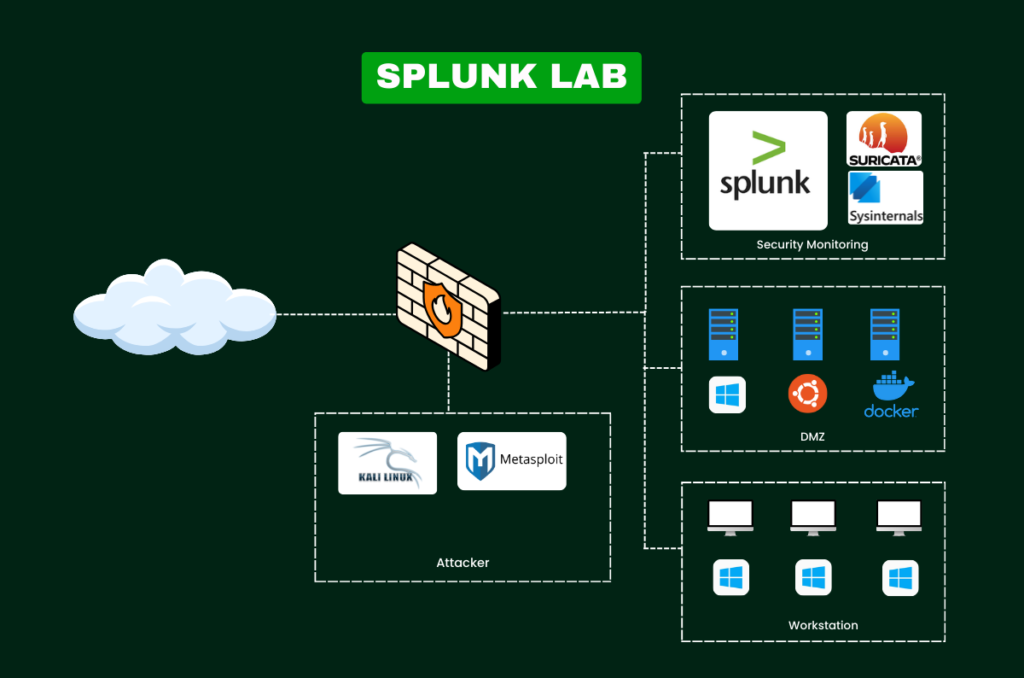Splunk for Security Analyst
Splunk for Security Analyst
- 4.721 students
- Last updated 25/7/2023
Course Description
This self-paced course provides you with a deep understanding of Suricata, an open-source network intrusion detection system (NIDS) that is widely used for monitoring and analyzing network traffic for suspicious activities. The course takes you from the essentials of installation and configuration to advanced threat detection techniques using Suricata’s rule sets, protocols, and logs.
Through hands-on labs and real-world examples, you’ll gain practical skills in creating custom alerts, analyzing packets, and detecting anomalies. Ideal for Security Analysts, SOC teams, and anyone eager to specialize in network security, this course will prepare you to handle network-based threats with expertise.

What You Will Learn
- Install and configure Suricata on Linux and Windows
- Understand and apply Suricata rule sets for detection
- Analyze network traffic to detect intrusions
- Configure alerts for suspicious activities in Suricata
- Interpret Suricata logs for threat intelligence
- Integrate Suricata with SIEM tools for SOC operations
- Tune Suricata for optimal performance and accuracy
- Conduct threat hunting using Suricata’s detection capabilities
Pre-requisites
- Basic networking knowledge and security concepts
- Some experience with network protocols and packet analysis
- Familiarity with Linux command line
Target Audience
Course Content
 What is SIEM?
What is SIEM?
 Introduction to Splunk
Introduction to Splunk
 Splunk Components
Splunk Components
 Splunk for SOC Components
Splunk for SOC Components
 Data Pipeline
Data Pipeline
 Splunk Default Ports
Splunk Default Ports
 Splunk App
Splunk App
 Index, Datasets, Sources and Sourcetypes
Index, Datasets, Sources and Sourcetypes
 Installing Splunk on Ubuntu Server
Installing Splunk on Ubuntu Server
 Installing Splunk Security Essentials
Installing Splunk Security Essentials
 Explore Fields
Explore Fields
 rename
rename
 table
table
 Fields
Fields
 head
head
 Top and rare
Top and rare
 stats
stats
 timechart
timechart
 chart
chart
 Data Ingestion and Parsing
Data Ingestion and Parsing
 Log Analysis
Log Analysis
 DNS Log Analysis
DNS Log Analysis
 DHCP Log Analysis
DHCP Log Analysis
 HTTP Log Analysis
HTTP Log Analysis
 Setting up Splunk UF on Ubuntu Machine
Setting up Splunk UF on Ubuntu Machine
 Task#1: Detection of Unauthorized Access on Linux Blocked by Fail2Ban
Task#1: Detection of Unauthorized Access on Linux Blocked by Fail2Ban
 Install and set up Fail2ban
Install and set up Fail2ban
 Simulate the SSH Brute force attack
Simulate the SSH Brute force attack
 Analyzing logs on Splunk
Analyzing logs on Splunk
 Task #2: Monitoring and Investigating Suspicious Process Execution
Task #2: Monitoring and Investigating Suspicious Process Execution
 Install Sysmon for Linux
Install Sysmon for Linux
 Setting up Splunk UF and Splunk Dashboard
Setting up Splunk UF and Splunk Dashboard
 Simulate a Suspicious Process Execution attack & Analyzing logs on Splunk
Simulate a Suspicious Process Execution attack & Analyzing logs on Splunk
 Task#3: File Integrity Monitoring for Sensitive Directories
Task#3: File Integrity Monitoring for Sensitive Directories
 Installing and setting up Auditd
Installing and setting up Auditd
 Setting up Splunk
Setting up Splunk
 Simulate Unauthorized change attempt & Analyzing logs on Splunk
Simulate Unauthorized change attempt & Analyzing logs on Splunk
 Setting up Windows Server 2022
Setting up Windows Server 2022
 Installing and setting up Splunk Universal Forwarder on Windows Server 2022
Installing and setting up Splunk Universal Forwarder on Windows Server 2022
 Installing Sysmon
Installing Sysmon
 Setting up Splunk
Setting up Splunk
 Simulate the attack and Visualize on Splunk Dashboard
Simulate the attack and Visualize on Splunk Dashboard
 Task 2: Investigating PowerShell Abuse on Windows Machines
Task 2: Investigating PowerShell Abuse on Windows Machines
 Setting up Splunk
Setting up Splunk
 Simulate the attack and Visualize on Splunk Dashboard
Simulate the attack and Visualize on Splunk Dashboard
 Task 3: Monitoring Windows Registry Changes
Task 3: Monitoring Windows Registry Changes
 Setting up Splunk
Setting up Splunk
 Simulate the attack and Visualize on Splunk Dashboard
Simulate the attack and Visualize on Splunk Dashboard
 Find Users IP Address
Find Users IP Address
 Discover List of Website visited by a suspicious user
Discover List of Website visited by a suspicious user
 Detecting Malicious Network Scanner
Detecting Malicious Network Scanner
 Setting up Splunk
Setting up Splunk
 Finding Malicious Traffic: Analyzing Connection to Specific domains
Finding Malicious Traffic: Analyzing Connection to Specific domains
 Detecting Data Exfiltration
Detecting Data Exfiltration
 Detecting Suspicious User Agent
Detecting Suspicious User Agent
 Monitor for connections to potentially phishing-related URLs
Monitor for connections to potentially phishing-related URLs
 Detect Successful use logins
Detect Successful use logins
 Detect repeated failed login attempts
Detect repeated failed login attempts
 Detect Local group membership changes
Detect Local group membership changes
 Detect Process Creation using certain accounts
Detect Process Creation using certain accounts
Instructor

Senior Security Consultant
- With over a decade of experience in cybersecurity and author of multiple works on security monitoring, Rajneesh is a trusted expert in open-source security tools, cloud security, and SOC automation. He has implemented and optimized ELK deployments for global clients and specializes in turning raw log data into actionable security intelligence. Rajneesh’s instruction style is both practical and thorough, ensuring you gain job-ready ELK skills.
This course includes:
- 8+ hours of hands-on learning
- 15+ Real World Scenarios
- Cloud-based Lab Access
- Life-time Community Access
- Learn from Mobile, TV

Testimonial
What alumni say about us






Common Questions
Most Popular Questions
Lorem ipsum dolor sit amet, consectetur adipiscing elit. Ut elit tellus, luctus nec ullamcorper mattis, pulvinar dapibus leo.
Suricata is an open-source network intrusion detection and prevention system (NIDS/NIPS) that monitors network traffic for suspicious activities. Using rules and protocol analysis, it can detect malicious patterns and alert security teams to potential threats.
No previous experience is needed. This course covers Suricata from the ground up, including installation, configuration, and advanced techniques. Basic networking knowledge is recommended, but we provide foundational lessons to ensure a smooth learning experience.
The course is self-paced, so completion time varies. Most students complete it within 4-6 weeks, but you’ll have lifetime access to revisit modules as needed.
By the end of the course, you’ll be able to set up and configure Suricata, create custom detection rules, analyze network traffic for threats, integrate with SIEM tools, and apply Suricata in real-world threat hunting scenarios. These skills are crucial for network security and SOC roles.
Yes, we update the course regularly to reflect the latest Suricata features and capabilities. The course content is aligned with the most current version, so you’ll learn the latest techniques and best practices.
Yes, you’ll receive a certificate from HaxSecurity upon completion, which you can display on LinkedIn and add to your resume to showcase your Suricata skills.
You’ll need a computer with Suricata installed, ideally on a virtual or physical Linux environment. Detailed installation instructions and setup support are included in the course.
Our support team is available to help with technical questions, and we offer a discussion forum for learners to interact with each other. Additionally, Rajneesh hosts regular live Q&A sessions where you can ask specific questions and gain further insights into the material.
Featured Online Course
Stay ahead with content based on the latest industry trends and practices.





